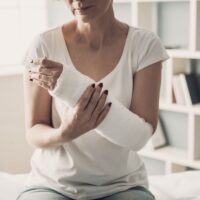Common Injuries in Trip and Fall Accidents

Trip and fall accidents are a frequent source of personal injury claims in New York City. These accidents can occur in a variety of settings, from uneven sidewalks to poorly maintained stairways, unmarked steps, torn carpets, bad lighting and countless other hazards. Injuries from a trip and fall can be painful, debilitating, severe or even permanent. They can land you in the hospital and throw you out of work and upend your life in a multitude of ways. An experienced premises liability attorney can help you recover compensation to deal with medical bills, lost wages, pain and suffering and other legal damages.
Below we describe some of the most common types of injuries that occur as a consequence of a trip and fall. If you have been hurt in a trip and fall accident in NYC, contact Leandros A. Vrionedes, P.C., to speak with a skilled and successful New York personal injury lawyer.
Fractures and Broken Bones
Fractures are among the most common injuries sustained in trip and fall accidents. When an individual trips and falls, the sudden impact can cause bones to break. Common fracture sites include the wrists, arms, ankles, and hips. Elderly individuals are particularly susceptible to hip fractures, which can have serious long-term consequences. Treatment often involves immobilization, casting, and in some cases, surgery.
Sprains and Strains
Sprains and strains occur when ligaments or muscles are overstretched or torn due to the sudden force of a fall. These injuries commonly affect the ankles, wrists, and knees. Symptoms include pain, swelling, bruising, and limited range of motion. Treatment typically involves rest, ice, compression, and elevation (RICE), along with physical therapy for more severe cases. Trip and fall victims with sprains and strains might require time off from work or light-duty restrictions to heal properly.
Head and Brain Injuries
Head injuries are a significant concern in trip and fall accidents. Since the trip and fall victim generally falls forward, they are likely to hit their head on the ground or another hard surface. Concussions, contusions, and traumatic brain injuries (TBIs) can result from such impacts. Symptoms of a head injury may include headaches, dizziness, confusion, nausea, and loss of consciousness. Immediate medical evaluation is crucial to assess the extent of the injury and determine the appropriate course of treatment.
Spinal Cord Injuries
Falls can also lead to spinal cord injuries, especially if the victim lands on their back or neck. Spinal cord injuries can range from minor sprains and strains to more severe damage such as herniated discs or fractures. These injuries can cause chronic pain, numbness, and in severe cases, paralysis. Treatment may involve medication, physical therapy, and possibly surgery, depending on the severity of the injury. A trip and fall down the stairs, often due to broken steps, uneven steps, clutter, or broken or missing handrails, is the type of trip and fall accident most likely to result in a spinal cord injury.
Cuts and Lacerations
Sharp objects or broken surfaces can cause cuts and lacerations during a fall. These injuries may require stitches or other medical interventions to prevent infection and promote proper healing. While cuts and lacerations might seem minor compared to other injuries, they can still lead to significant pain, scarring, and potentially serious complications if not treated promptly.
Soft Tissue Injuries
Soft tissue injuries, including bruises, contusions, and hematomas, are common in trip and fall accidents. These injuries occur when blood vessels are damaged, causing blood to pool under the skin. While they often heal on their own with time, severe soft tissue injuries may require medical treatment to alleviate pain and reduce swelling.
Importance of Seeking Legal Assistance
If you or a loved one has been injured in a trip and fall accident, it is essential to seek legal assistance as soon as possible. At Leandros A. Vrionedes, P.C., we understand the physical, emotional, and financial toll these injuries can take on victims and their families. Our experienced team is committed to helping you navigate the legal process and secure the compensation you need for medical expenses, lost wages, pain and suffering, and other damages.
Steps to Take After a Trip and Fall Accident
- Seek Medical Attention: Your health and safety are the top priority. Get medical help immediately, even if your injuries seem minor.
- Document the Scene: If possible, take photos of the accident scene, including any hazards that contributed to your fall.
- Report the Accident: Inform the property owner, manager, or relevant authority about the accident. Make sure to get a copy of the incident report.
- Gather Information: Collect contact information from any witnesses and keep a record of your medical visits and expenses.
- Consult a Personal Injury Lawyer: Contact Leandros A. Vrionedes, P.C. to discuss your case and explore your legal options.
Contact Leandros A. Vrionedes, P.C., for Help With Trip and Fall Accidents in New York City
Trip and fall accidents can lead to a wide range of injuries, from minor cuts and bruises to serious fractures and head injuries. Understanding the common types of injuries and taking appropriate steps after an accident can make a significant difference in your recovery and legal outcome. At Leandros A. Vrionedes, P.C., we are here to help you through this challenging time and fight for the compensation you deserve. Call us today at 212-889-9362 for a free consultation.


